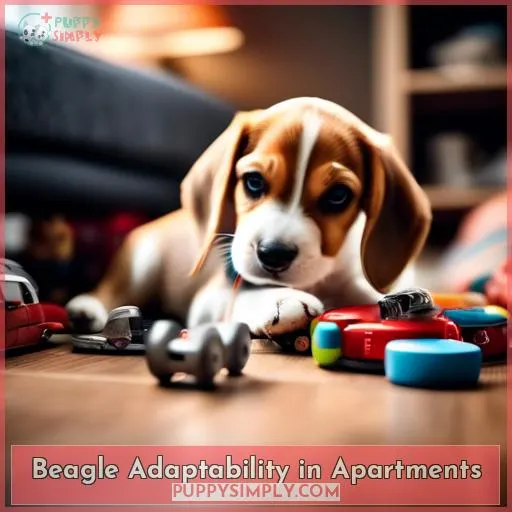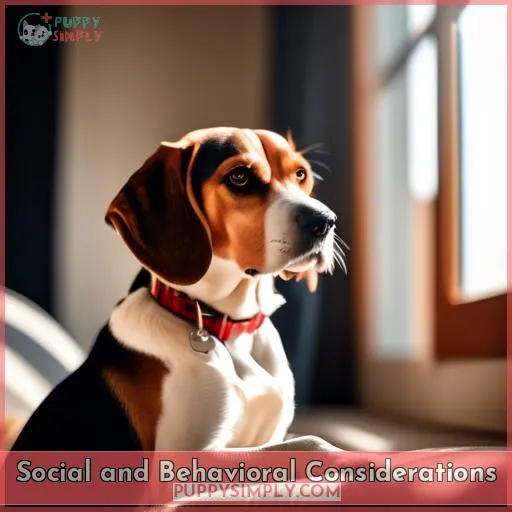This site is supported by our readers. We may earn a commission, at no cost to you, if you purchase through links.

Got a snug apartment and yearning for a canine companion?
Then prick up those ears – a Beagle could be the perfect pup for you!
Sure, their trademark howl may raise some eyebrows, but with proper training and exercise, Beagles can make marvelous apartment pets.
Their moderate size and mellow temperament mean they can thrive in smaller spaces.
But separation anxiety and boredom must be managed.
If you provide a Beagle daily walks, playtime, and chew toys galore, you’ll have a merry little hound happy in your humble abode.
Table Of Contents
- Key Takeaways
- Beagle Adaptability in Apartments
- Challenges and Solutions
- Social and Behavioral Considerations
- Health and Grooming
- Making the Decision
- Frequently Asked Questions (FAQs)
- How long can a Beagle be left alone in an apartment?
- What are some signs of separation anxiety in Beagles?
- Do Beagles get along with other pets, such as cats or smaller dogs?
- How much exercise does a Beagle need each day?
- Are Beagles prone to any specific health issues that may require special attention in an apartment setting?
- Conclusion
Key Takeaways
- Beagles are adaptable to apartment living with their moderate size and mellow temperament, but they require daily walks, playtime, and mental stimulation.
- Challenges include managing barking and separation anxiety, which require positive reinforcement, crate training, and routine.
- Beagles crave companionship, need consistent training, and thrive with interactive toys and socialization to prevent boredom and destructive behaviors.
- Regular brushing, exercise, and preventive care are essential for maintaining their health, while their energy level and barking tendencies should be considered before deciding on an apartment.
Beagle Adaptability in Apartments
When considering a beagle for an apartment, you’ll need to ensure their exercise, training, and social needs are met within the space.
Daily walks, playtime, and mental stimulation with toys are essential for apartment beagles.
Providing enough room for comfortable movement and activity is also key for their adaptability.
Exercise Needs: Importance of Daily Walks and Playtime
Although beagles require plenty of exercise, you can meet their needs in an apartment by taking them on daily walks and providing indoor playtime.
- Take your beagle on morning and evening neighborhood walks for ample outdoor exercise.
- Provide interactive toys like puzzle feeders to entertain indoors.
- Rotate a variety of chew toys to prevent boredom.
- Teach fun training techniques like hide-and-seek for mental enrichment.
Mental Stimulation: Puzzle Toys, Training, and Socialization
Puzzle Toys, Training, and Socialization
- You’ll need puzzle toys, training, and socialization to keep your beagle mentally engaged in limited space.
- Interactive playtime builds mental agility through training tricks and games.
- Frequent socialization opportunities lead to better separation behaviors.
- Providing daily mental workouts via bonding activities combats anxiety while cooped up indoors.
Space Requirements: Ensuring Enough Room for Comfort and Activity
You’ll need to ensure your home provides enough room for a beagle’s comfort and activity.
Mental stimulation demands space for play and training.
Consider indoor exercise options like fetch down halls or up stairs to meet activity needs.
Get creative with playtime by setting up tunnels or obstacles.
Compact training methods like sit stays allow mental stimulation without excessive space demands.
Balance comfort and activity by designating beagle spaces for beds and toys while also allowing room for movement and play.
Careful apartment layouts enable properly stimulating beagles despite apartment size constraints.
Challenges and Solutions
You’ll need to put some effort into managing a beagle’s tendency to bark and howl.
If they experience separation anxiety when left alone, there are strategies to help mitigate anxiety issues.
It’s also key to prevent escapes and ensure a secure home environment for everyone’s safety.
Vocalization: Managing Barking and Howling Tendencies
Bark mitigation requires your attention since Beagles’ natural vocal inclinations don’t accommodate apartment living.
Implement positive reinforcement training to curb excessive vocalization.
Provide puzzle toys and activities to occupy your Beagle’s mind.
Communicate regularly with neighbors to address any noise concerns proactively.
Separation Anxiety: Strategies to Mitigate Anxiety When Left Alone
How can you mitigate your beagle’s separation anxiety when left alone in an apartment?
Implementing crate training, providing interactive toys, and establishing a consistent routine can help ease their stress.
Strategy: Crate Training
How It Helps: Creates a safe, cozy space
Benefits: Reduces anxiety, aids potty training
Strategy: Interactive Toys
How It Helps: Keeps your beagle mentally stimulated
Benefits: Prevents boredom, destructive behaviors
Strategy: Consistent Routine
How It Helps: Provides structure and predictability
Benefits: Promotes calmness, eases anxiety
Safety Measures: Preventing Escapes and Ensuring a Secure Environment
Your Beagle’s safety is paramount, so take measures to prevent escapes and guarantee a secure environment.
Outdoor Safety:
- Use a harness and leash during walks to prevent sudden escapes.
Escape Prevention:
- Ensure windows and doors are securely closed; consider installing a doggy door for easy access.
Secure Boundaries:
- Create a safe play area with clear boundaries, both indoors and outdoors.
Social and Behavioral Considerations
Beagles crave companionship, so you’ll need to make sure you have enough time to spend with them.
Consistent training and behavior management are key to a well-behaved Beagle.
Building positive relationships with your neighbors will help address any potential noise concerns.
Companionship: Beagles’ Need for Social Interaction and Company
Aren’t Beagles social butterflies who thrive on interaction with their humans and other animals?
As a Beagle owner, you’re their world, and they crave your attention.
So, give them plenty of indoor entertainment to keep their minds active.
You can also socialize them at the dog park, but be mindful of your neighbors’ perspectives.
Training and Obedience: Importance of Consistent Training and Behavior Management
Moreover, how will you handle consistent training and behavior management to prevent problem behaviors in your apartment?
Beagles thrive on routine and boundaries.
Establish clear rules, use positive reinforcement, and avoid punishment.
Enroll your beagle in obedience classes to master basic commands.
Engage them mentally with interactive toys and games, and socialize them with other dogs and people to prevent boredom and destructive behaviors.
Interaction With Neighbors: Building Positive Relationships to Address Potential Noise Concerns
By building positive relationships with neighbors, you can address potential noise concerns caused by your Beagle’s barking and howling.
- Engage in friendly conversations, share treats, and offer to walk their dogs, creating a sense of camaraderie and understanding.
- Be mindful of noise levels, especially during quiet hours, and apologize promptly if your Beagle causes any disturbance.
- Invite neighbors over for coffee or a small gathering, fostering a sense of community and empathy.
Health and Grooming
You’ll need to brush your Beagle regularly to keep its coat healthy and prevent mats.
You should also be aware of common Beagle health issues like hip dysplasia, eye problems, and epilepsy.
Providing your Beagle with enough exercise will help prevent destructive behavior and keep it mentally healthy.
Grooming Needs: Low Maintenance but Regular Brushing Required
Your Beagle’s grooming routine will be easy to manage with regular brushing.
This low-maintenance breed has a short, smooth coat that sheds moderately.
Brush your Beagle weekly to remove dead hair and keep its coat healthy and shiny.
This simple grooming routine will help keep your Beagle looking and feeling its best, while also reducing the amount of shedding in your apartment.
Health Concerns: Awareness of Common Beagle Health Issues
To keep your Beagle healthy, be aware of potential issues like intervertebral disc disease, hip dysplasia, and cherry eye.
Preventive care, including regular checkups and vaccinations, is vital.
These genetic predispositions can lead to pain, lameness, and even paralysis.
Early detection and intervention are key to managing these conditions and ensuring your Beagle’s well-being.
Exercise to Prevent Destructive Behavior: Role of Physical Activity in Maintaining Mental Health
Exercising your Beagle regularly helps it burn energy and stay mentally stimulated, reducing the likelihood of destructive behaviors.
Physical enrichment and mental well-being go hand in hand for Beagles.
Exercise routines create a behavioral balance, keeping them engaged and emotionally stable.
Daily activity engagement reduces stress and provides behavioral enrichment.
Exercise promotes overall health and mental stimulation, preventing boredom and destructive tendencies.
Regular exercise keeps your Beagle happy, healthy, and well-behaved in your apartment.
Making the Decision
Before deciding, consider the pros, cons, and your lifestyle.
Are you prepared to deal with their energy level and barking tendencies?
Do you have the time to exercise and train them regularly?
Beagles can be great apartment dogs, but it’s important to make sure their needs align with your living situation.
Pros and Cons: Weighing the Benefits Against Potential Challenges
Now that you’re aware of Beagles’ exercise, training, separation anxiety, and health needs, let’s weigh the pros and cons of having one in an apartment:
- Beagles’ exercise demands can be met with daily walks and indoor playtime.
- Their noise level can be managed through training and desensitization.
- Separation anxiety can be eased with socialization and a structured routine.
- Space optimization and behavior modification can address their living space needs.
Ultimately, the decision to bring a Beagle into your apartment depends on your ability to provide the necessary care and attention to ensure its well-being.
Apartment Policies: Checking Pet Policies and Breed Restrictions
Before bringing a Beagle home, check your apartment’s pet policies and breed restrictions to ensure they allow the breed.
Some apartments have:
Pet-friendly policies:
- Ensure your apartment complex allows pets.
Inquire about any specific restrictions or guidelines.
Breed acceptance:
- Certain breeds may be restricted due to size, temperament, or local regulations.
Confirm that Beagles are permitted.
Weight restrictions:
- Some apartments have weight limits for pets.
- Verify if there’s a weight limit and if it accommodates your Beagle.
Lifestyle Compatibility: Assessing if a Beagle’s Needs Align With the Owner’s Living Situation and Daily Routine
Your lifestyle must align with a Beagle’s exercise demands and social needs to ensure a harmonious living situation.
Assess your daily routine and space utilization to determine if a Beagle’s needs align with your lifestyle.
Evaluate your ability to provide ample exercise, mental stimulation, and companionship to ensure the Beagle’s well-being.
| Assessment Criteria | Daily Routine Compatibility |
|---|---|
| Exercise Management | Can you commit to daily walks and playtime sessions? |
| Space Utilization | Do you have enough space for the Beagle to move and play comfortably? |
| Lifestyle Evaluation | Is your lifestyle active enough to match the Beagle’s energy levels? |
Frequently Asked Questions (FAQs)
How long can a Beagle be left alone in an apartment?
Beagles thrive on human companionship and can suffer from separation anxiety.
Leaving them alone for extended periods, more than eight hours, can lead to destructive behaviors and emotional distress.
Plan accordingly to ensure your Beagle’s well-being.
What are some signs of separation anxiety in Beagles?
Separation anxiety in beagles can manifest as:
- Pacing
- Whining
- Barking
- Destructive behavior
- Accidents indoors
When left alone.
Do Beagles get along with other pets, such as cats or smaller dogs?
Beagles can indeed coexist with other pets, such as cats and smaller dogs, if properly introduced and socialized.
Harmony depends on individual personalities and training, so patience and positive reinforcement are key to creating a peaceful multi-pet household.
How much exercise does a Beagle need each day?
Beagles’ boundless energy demands daily exercise.
Engage your Beagle in stimulating activities, whether it’s a brisk walk, a game of fetch, or an agility course, to keep them happy and healthy.
Are Beagles prone to any specific health issues that may require special attention in an apartment setting?
Beagles’ boundless energy can turn your apartment into a whirlwind of fur and mischief.
Watch out for those floppy ears collecting every crumb and dust bunny in sight!
Conclusion
Imagine a compact apartment teeming with happiness, laughter, and the occasional howl of joy.
A Beagle, a small dog with a big heart, scampers about, its tail wagging a path of pure bliss.
With proper training, exercise, and love, Beagles can thrive in apartments, filling them with warmth and companionship.
If you’re seeking a devoted furry friend to share your urban adventures, a Beagle may be the perfect pooch for your apartment living.











